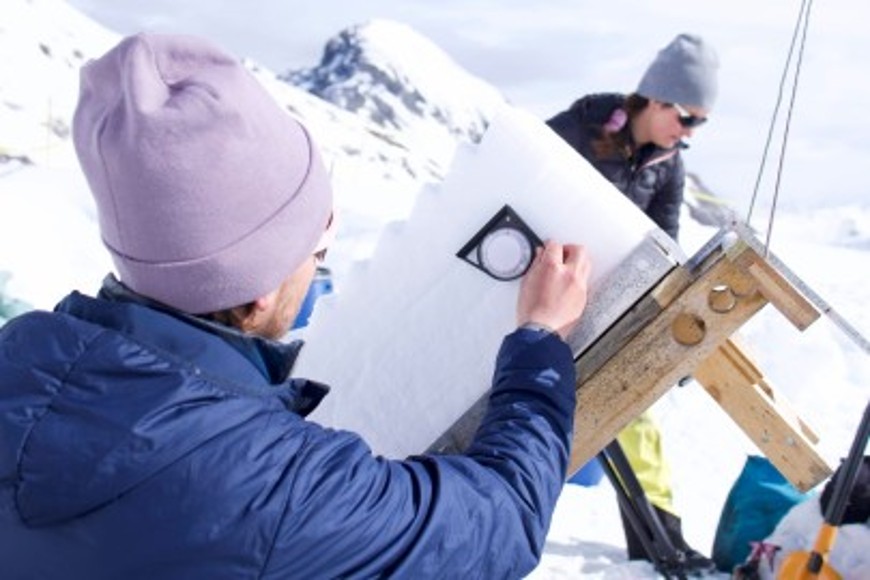Mr. Rosendahl's sense for snow
Press review: an article in the Frakfurter Rundschau
2025/05/08 by Astrid Ludwig
A mechanical engineer discovers his love of ice crystals – now he heads the TU's avalanche research center.

Perhaps Philipp Rosendahl's future employer would one day have been a large car company or an aircraft manufacturer. The thirty-five-year-old studied mechanical engineering at TU Darmstadt and researched fracture mechanics and, in particular, adhesive joints for his doctoral thesis. These joints are often used in car construction to protect occupants because they absorb a lot of kinetic energy in the event of a collision. Surely a topic that would later lead to success in industry. But things turned out differently.
The fact that the mechanical engineering graduate became a nivologist, a snow researcher, is primarily due to Rosendahl's love of winter sports. “It was pure interest,” says the Berlin native. As a doctoral student, he investigated the mechanical behavior of these glued joints and how cracks develop in them. The passionate ski tourer realized that glued joints and snow layers are similar in many respects. “One of these layers will be the weakest and the first to break.” In the mountains, it is often the so-called surface frost, a thin, fragile layer of fine ice crystals that is covered by freshly fallen snow. “It's about the same mathematical and mechanical principles as an adhesive bond,” says the scientist.
If a layer of ice breaks or starts to slide, it can be dangerous in the snowy regions. Which is why Rosendahl always has his most important companion with him when he straps on his boards for the next mountain tour: his avalanche backpack, equipped with a kind of airbag and an avalanche transceiver, known as an avalanche transceiver or beep for short. This enables him to locate victims of a snowfall or be located himself. Long before he became an avalanche researcher himself, the avid skier studied the subject intensively, always studying weather conditions and snow reports before going on tours.
In a student research project he supervised, the mechanical engineer with a flair for snow therefore looked at how the findings from mechanics could be used to improve avalanche warnings – and ended up at the International Snow Science Workshop in Innsbruck in 2018. This is an international conference that takes place every two years in Europe, the USA or Canada and is attended by snow and avalanche researchers and industry practitioners from all over the world. “I was immediately well received and there was a lot of interest in working together,” he reports.
Rosendahl's topic filled a gap: “The engineering aspect has been missing from the community until now.” There are many researchers from the fields of physics, meteorology and geosciences, but no mechanical engineers. This also gave the engineer new impetus. “I met passionate outdoor people, a small, friendly research community without the usual scientific competition.”
The Darmstadt native gained access to databases, research facilities and collaborations such as with the Swiss Avalanche Research Center in Davos. “Snow research has many aspects – from hydrology to climate change and the increasingly topical question of what actually happens when it gets warmer.” In field tests and in exchange with practitioners, the TU scientist created snow profiles and researched the icy masses layer by layer.
After completing his doctorate in mechanical engineering, it was clear to the young researcher that “I wanted to stay at the university as a postdoc, which was never really the plan”. Rosendahl found a supporter in Jens Schneider – then Head of the Institute of Structural Analysis and Design at the Department of Civil and Environmental Engineering, now Rector of the Vienna University of Technology.
In 2020, the “Center of Snow and Avalanche Research” was established at TU Darmstadt, of which Rosendahl is group leader. The university is now funding him as an “Athene Young Investigator” for his work. Two doctoral students are currently working with him. More will join them by the end of 2025. “There are many research applications in progress,” he notes with satisfaction.
The center is unique. The researchers develop computational models and devise experiments using mathematical, numerical methods of fracture mechanics. This complements the field tests of the Davos Avalanche Research Institute well, says the TU scientist. In a study, the Darmstadt researchers found that even a single person can put so much strain on the snow that a deep layer collapses and the snowpack slides off. Experts refer to this as anti-cracking. According to Rosendahl, the basic fracture-mechanical properties that lead to slab avalanches are still largely unknown, but are crucial for predicting what triggers avalanches. His team has developed a method that can be used to measure the fracture toughness of weak snow layers under controlled conditions in the field.
The technical expertise from Darmstadt is also being used to create new devices. For example, a mobile snow tester jointly designed by a TU doctoral student and a Master's student to simultaneously measure the pressure and shear stress of snow samples. The device fits into a rucksack. “This is important because the logistical effort involved in penetrating snow and mountain regions is always very high,” emphasizes Rosendahl. Being a snow researcher is physically demanding. “You have to be fit. Sometimes I ask myself, why am I doing this? But afterwards it's just great,” he says and laughs. The snow expert from Darmstadt has a dream: he would like to do research north of the Arctic Circle or in the Himalayas one day.

